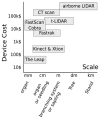Assessing the potential of low-cost 3D cameras for the rapid measurement of plant woody structure
- PMID: 24287538
- PMCID: PMC3892875
- DOI: 10.3390/s131216216
Assessing the potential of low-cost 3D cameras for the rapid measurement of plant woody structure
Abstract
Detailed 3D plant architectural data have numerous applications in plant science, but many existing approaches for 3D data collection are time-consuming and/or require costly equipment. Recently, there has been rapid growth in the availability of low-cost, 3D cameras and related open source software applications. 3D cameras may provide measurements of key components of plant architecture such as stem diameters and lengths, however, few tests of 3D cameras for the measurement of plant architecture have been conducted. Here, we measured Salix branch segments ranging from 2-13 mm in diameter with an Asus Xtion camera to quantify the limits and accuracy of branch diameter measurement with a 3D camera. By scanning at a variety of distances we also quantified the effect of scanning distance. In addition, we also test the sensitivity of the program KinFu for continuous 3D object scanning and modeling as well as other similar software to accurately record stem diameters and capture plant form (<3 m in height). Given its ability to accurately capture the diameter of branches >6 mm, Asus Xtion may provide a novel method for the collection of 3D data on the branching architecture of woody plants. Improvements in camera measurement accuracy and available software are likely to further improve the utility of 3D cameras for plant sciences in the future.
Figures








References
-
- Niinemets U., Valladares F. The Architecture of Plant Crowns: From Design Rules to Light Capture and Performance. In: Pugnaire F., Valladares F., editors. Functional Plant Ecology. Taylor and Francis; New York, NY, USA: 2007.
-
- Hopkinson C., Chasmer L., Young-Pow C., Treitz P. Assessing forest metrics with a ground-based scanning lidar. Can. J. For. Res. 2004;34:573–583.
-
- Lim K.S., Treitz P.M. Estimation of above ground forest biomass from airborne discrete return laser scanner data using canopy-based quantile estimators. Scand. J. For. Res. 2004;19:558–570.
-
- Yao T., Yang X., Zhao F., Wang Z., Zhang Q., Jupp D., Lovell J., Culvenor D., Newnham G., Ni-Meister W. Measuring forest structure and biomass in New England forest stands using Echidna ground-based lidar. Remote Sens. Environ. 2011;115:2965–2974.
MeSH terms
LinkOut - more resources
Full Text Sources
Other Literature Sources

